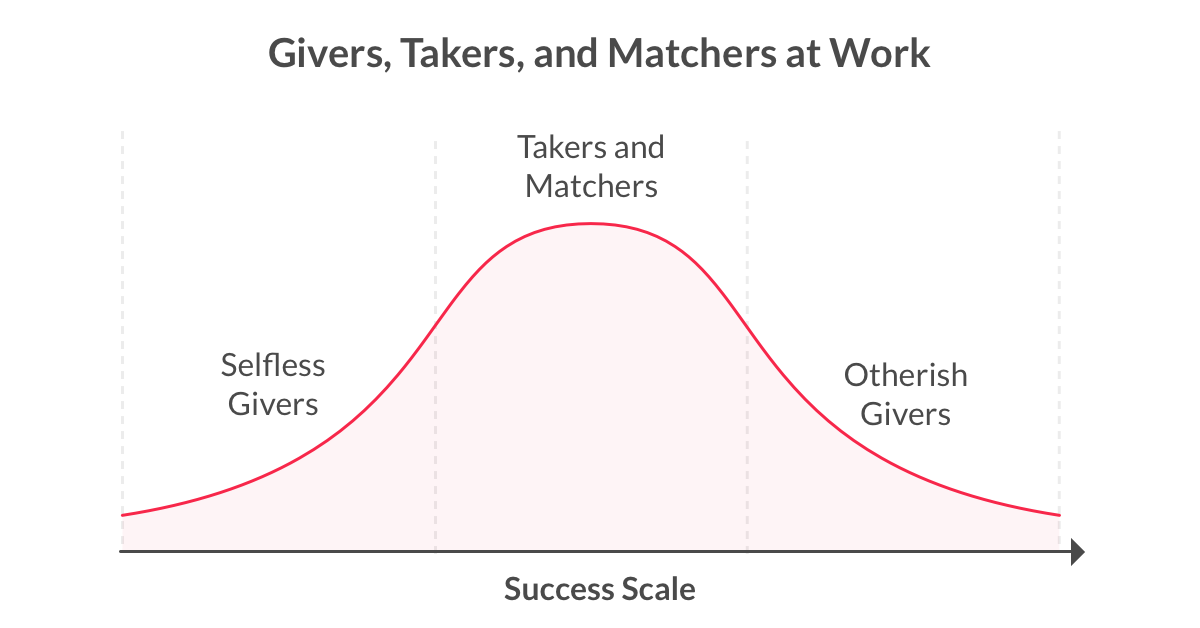You’re at lunch with a friend who’s looking for a new job. They tell you they’re interested in a company where your college friend works. You haven’t spoken to your friend in a few years. What would you do?
1. Tell your friend you’ll make the introduction
2. Tell your friend you’ll make the introduction, and then ask them for help on your own issue
3. Tell your friend you don’t feel comfortable making the introduction since you’re no longer in touch with your college friend
It turns out your answer to this question reflects your ‘reciprocity style,’ which is the way you approach interactions with others. According to Adam Grant, author of Give and Take, there are three different types of reciprocity types: givers, takers, and matchers.
Givers, takers, and matchers
What’s the difference between these types?
Takers are self-focused and put their own interests ahead of others’ needs. They try to gain as much as possible from their interactions while contributing as little as they can in return.
Matchers like to preserve an equal balance of giving and taking. Their mindset is: “If you take from me, I’ll take from you. If you give to me, I’ll give to you.”
Givers are others-focused, and tend to provide support to others with no strings attached. They ask themselves, “How can I add value for this person? What can I contribute?”

So what type are you? Turns out most people hover in the middle, and behave as matchers, answering option B above (I’ll introduce you to my college friend, but I need help from you).
Humans have an innate tendency to be reciprocal, and givers and takers represent two extremes.
But while givers are the most generous in our society, matchers play an important role. They make sure what goes around, comes around. They reward givers for their generous behavior, and seek revenge when they, or others, are being mistreated.
Givers, takers, and matchers at work
Guess which of these types is the most successful at work.
Turns out, givers tend to be the worst performers. They’re at a disadvantage across a wide range of occupations, because they sacrifice their own success to help others succeed, according to Grant’s research.
So that must mean takers or matchers are the top performers, right? Not exactly.
It’s the givers again.
Yeah, you read right. The worst and best performers at work are others-focused, and takers and matchers tend to land in the middle.

Why is that? Since takers develop reputations for putting others last, matchers tend to return the favor and try to knock them down, research shows. That’s why takers rarely succeed in building strong relationships and networks.
On the other hand, matchers root for givers to succeed, since they tend to match good deed with good deed. Everyone loves, trusts, and supports givers, since they add value to others and enrich the success of the people around them.
In short, givers succeed because their giving leads to quality relationships, which benefit them in the long run. With such strong relationships, it’s no wonder givers are also happier people than takers.
But wait, back up. If being a giver creates stronger relationships (and even makes you happier), why are some givers at the bottom of the success ladder, while others are at the top?
Selfless givers vs. otherish givers
There are two types of givers: ‘selfless’ givers and ‘otherish’ givers.
Selfless givers, as you may guess, are the ones who drop everything to help people all the time, which means they tend to fall behind on their own work. Therefore, they usually end up at the bottom of the success ladder (though they’re still happier people than takers).
On the other hand, otherish givers are smart and strategic about their giving. While they’re just as much givers as the selfless givers, they’ve learned to successfully navigate a world with matchers and takers, so others don’t take advantage of them.
At this point, you must be asking: what steps can I take to become a successful giver? After all, being a successful giver comes with many perks: stronger relationships, increased happiness, and better performance at work.
Well, we’re glad you asked. Here are a few tricks and tools successful givers have up their sleeves to help others while avoiding burnout.
How to be a successful giver
1. 5-minute favors
What to do:
Do other people small favors that take no more than 5 minutes – like making an introduction, giving feedback, and offering advice.
Why it works:
Made famous by serial entrepreneur Adam Rifkin, 5-minute favors are those small yet impactful favors you do for others that take no more than 5 minutes. Doing these quick favors for a coworker or friend can go a long way in strengthening your relationships.
2. Ask for help
What to do:
Ask a friend or coworker for help on an issue you’re having, without taking up too much of their time.
Why it works:
While asking for help doesn’t sound like a quintessential giver move, doing so comes with some surprising benefits. It gives them the opportunity to be a giver, but also makes them feel good and smart.
According to Grant, one of the best ways to build strong relationships is to seek advice, because it creates meaningful opportunities for someone to contribute to your life, and feel fulfilled by it.
3. Give all at once
What to do:
Devote a particular day or part of a day each week to helping people out.
Why it works:
There are two ways to give: you can sprinkle random acts of kindness throughout your week, or chunk all of your giving acts into one day. Which is most effective? The chunking, research shows, because it leaves you with a bigger psychological boost of feeling appreciation and meaningfulness, which will motivate you to continue being a giver.

4. Specialize in favors
What to do:
Pick one or two ways of helping that you enjoy and excel at, rather than being jacks of all trades.
Why it works:
This way, you can help in a way that energizes you instead, of exhausts you. This trick will also allow you to gain a reputation as a person with a particular expertise you’re willing to share, rather than as a nice person who’s freely available.
Bonus? People won’t come to you for favors that don’t fit these skills.
5. Keep an eye out for takers
What to do:
Spot takers early, based on reputation and past experience, and only help them if they like you.
Why it works:
Takers like to milk givers for favors, because of givers’ reputations. To avoid this, take on the mentality of a matcher. In other words, if a taker asks for help, say “sure, I’ll help you if you agree to help me with something else in return.”
Give, give, give!
Practice these tips and tricks, and you’ll be a successful giver in no time. But the key to being a successful giver is also being an authentic giver. The less you try to give to get, the more you’ll succeed.
Check out the next article in our Givers, Takers, Matchers series, where we explore how these reciprocity styles affect not only individuals, but also industries.
– – –
Are you a giver, taker, or matcher?
Here are a few more questions from Adam Grant’s Give and Take quiz to help you find out.
1. You and a stranger will both receive some money. You have three choices about what you and the stranger receive, and you’ll never see or meet the stranger. Which option would you choose?
a) I get 8 € and the stranger gets 4 €
b) I get 5 €, and the stranger gets 7 €
c) I get 5 €, and the stranger gets 5 €
2. In 2006, after the devastation caused by Hurricane Katrina, a US bank executive led a team of employees on a trip to help rebuild New Orleans. Why do you think he did this?
a) He wanted to make headlines for being a generous, giving organization
b) He felt compassion for the victims and wanted to do whatever he could to help
c) He wanted to show his support for bank employees who had family members in New Orleans
3. You’re applying for a job as a manager, and a former boss writes you a glowing recommendation letter. What would you be most likely to do?
a) Go out of my way to make a good impression on my new boss, so I can line up another strong recommendation for the future
b) Offer to write a recommendation letter for one of my own former employees, so I can pay it forward
c) Look for ways to help my former boss, so I can pay it back
4. You’re working on a project with two colleagues, and there are three tasks that need to get done. As you discuss how to divide tasks, it becomes clear that all three of you are extremely interested in two of the tasks, but view the third as quite boring. What would you do?
a) Try to convince one of my colleagues to do the boring task
b) Volunteer for the boring task without asking for anything in return
c) Volunteer for the boring task and ask my colleagues for a favor later
5. A few years ago, you helped an acquaintance named Jamie find a job. You’ve been out of touch since then. All of a sudden, Jamie sends an email introducing you to a potential business partner. What’s the most likely motivation behind Jamie’s email?
a) Jamie wants to ask for help again
b) Jamie genuinely wants to help me
c) Jamie wants to pay me back
If you answered mostly A’s, you’re a taker. If you answered mostly B’s, you’re a giver. If you answered mostly C’s, you’re a matcher. 🙂


